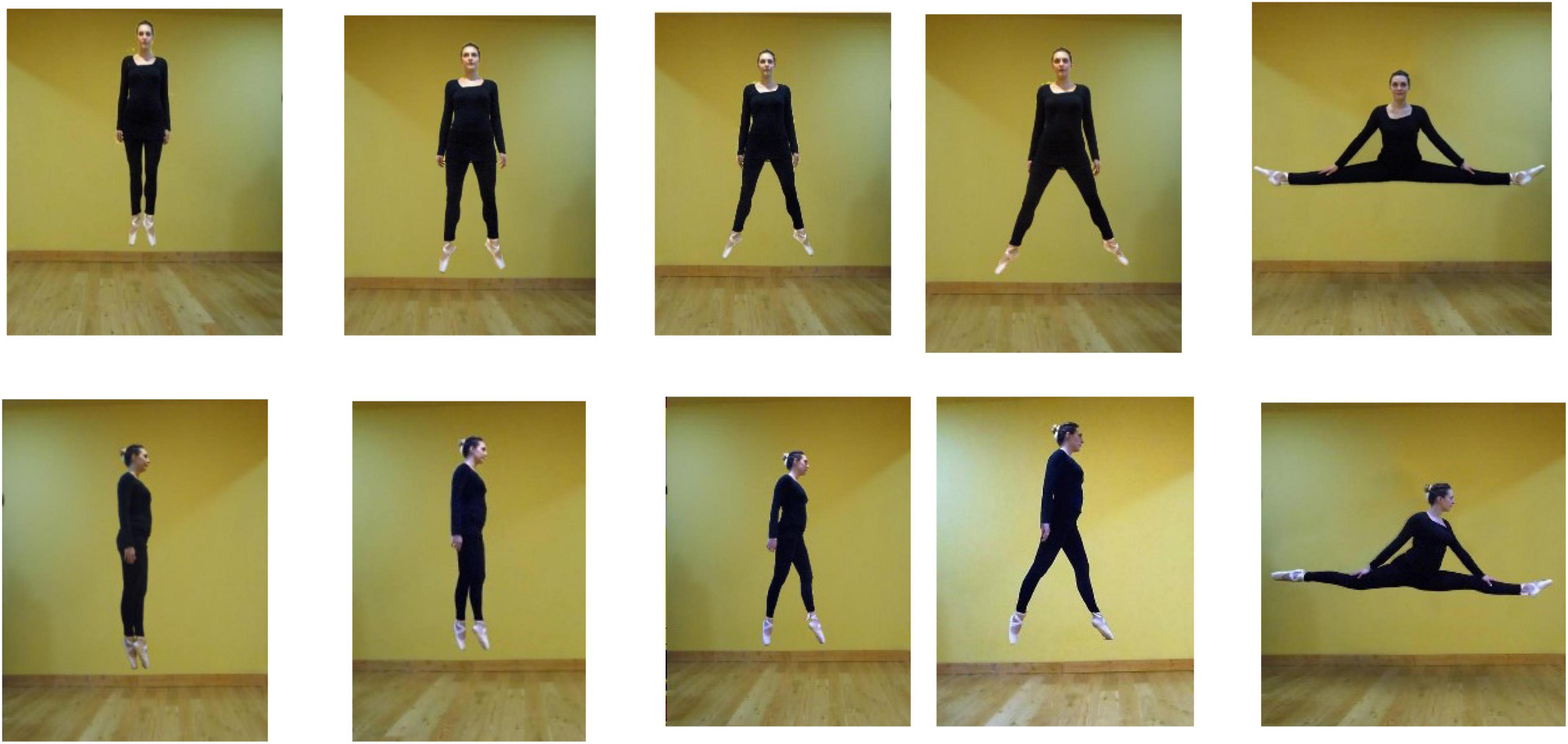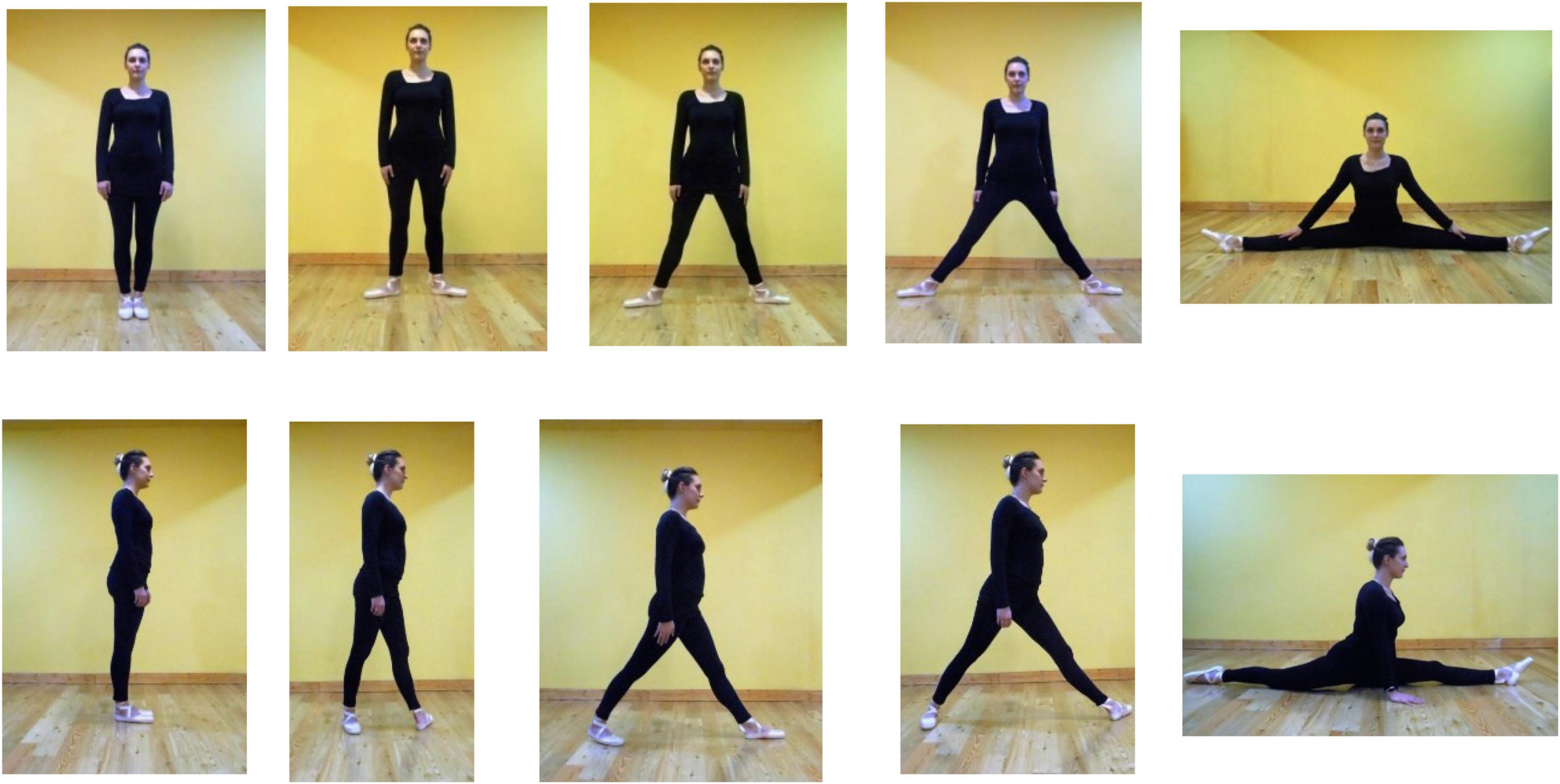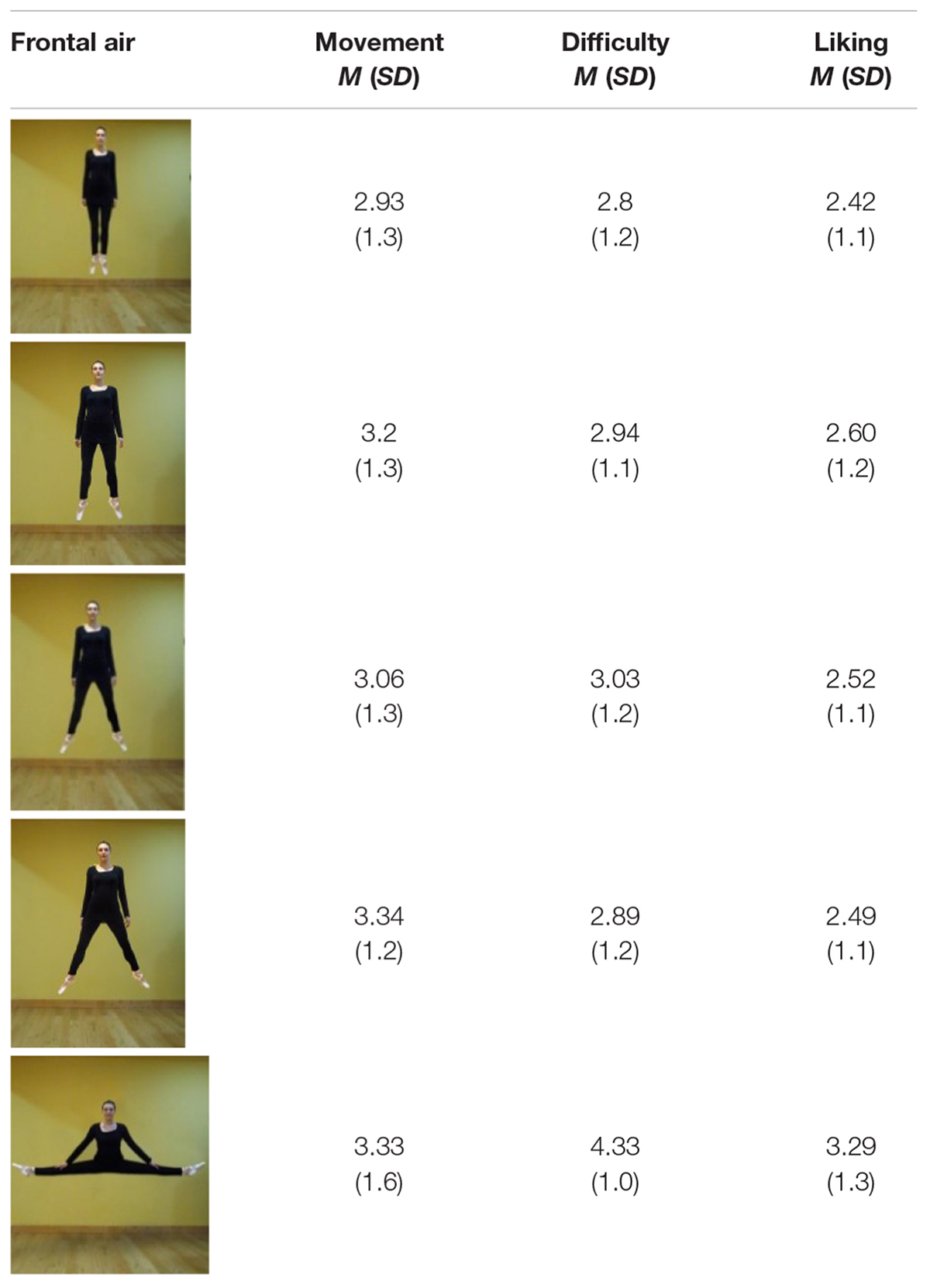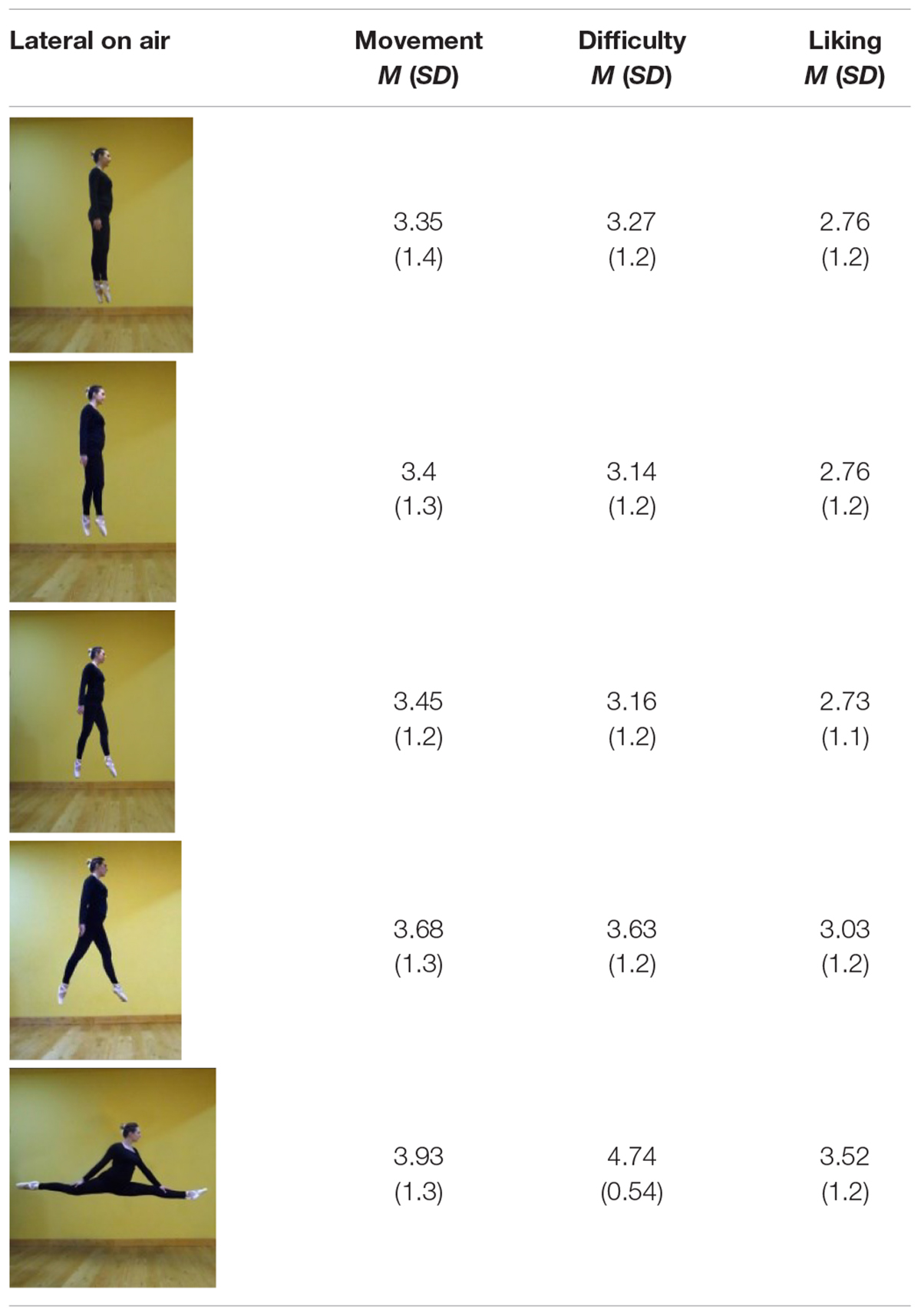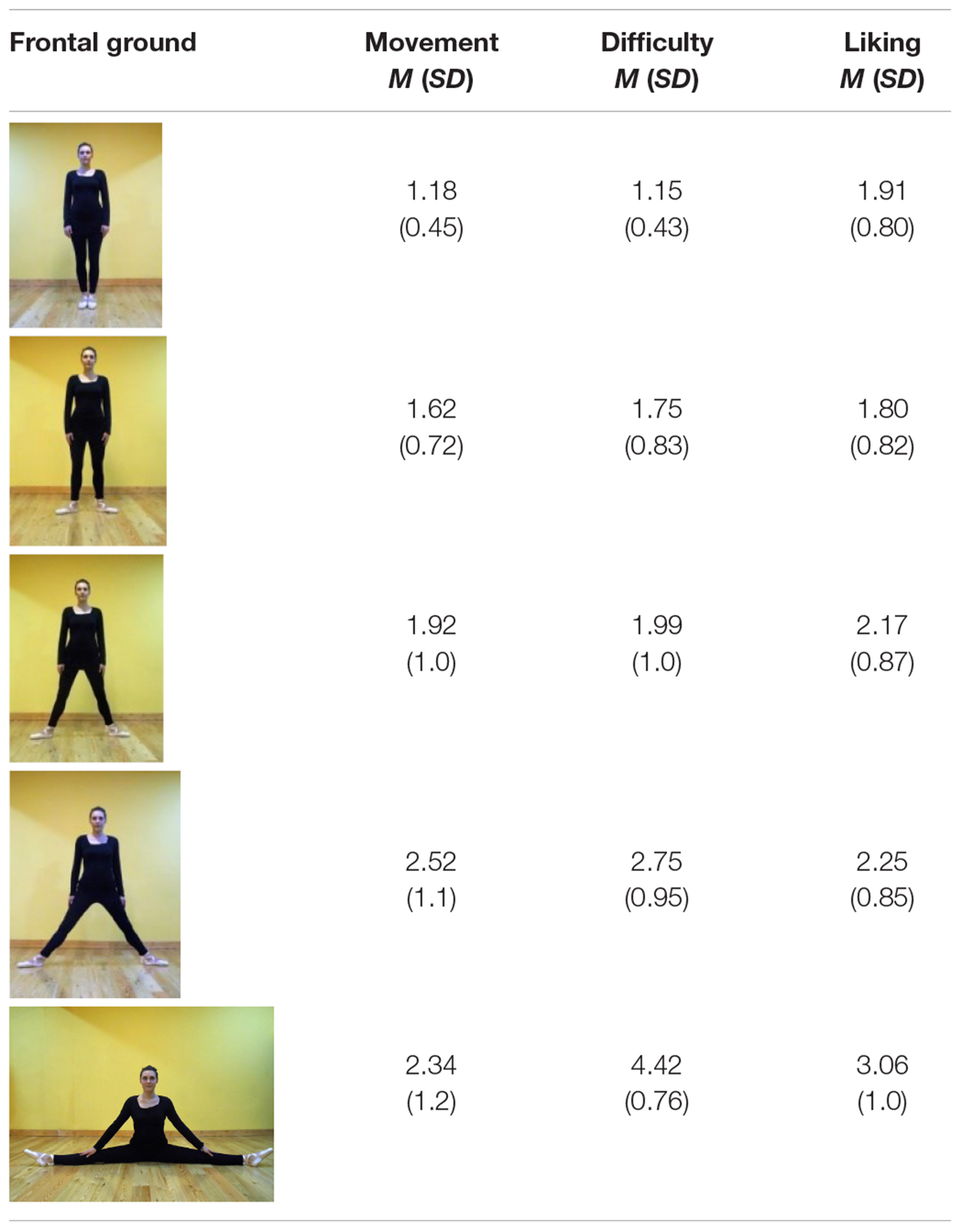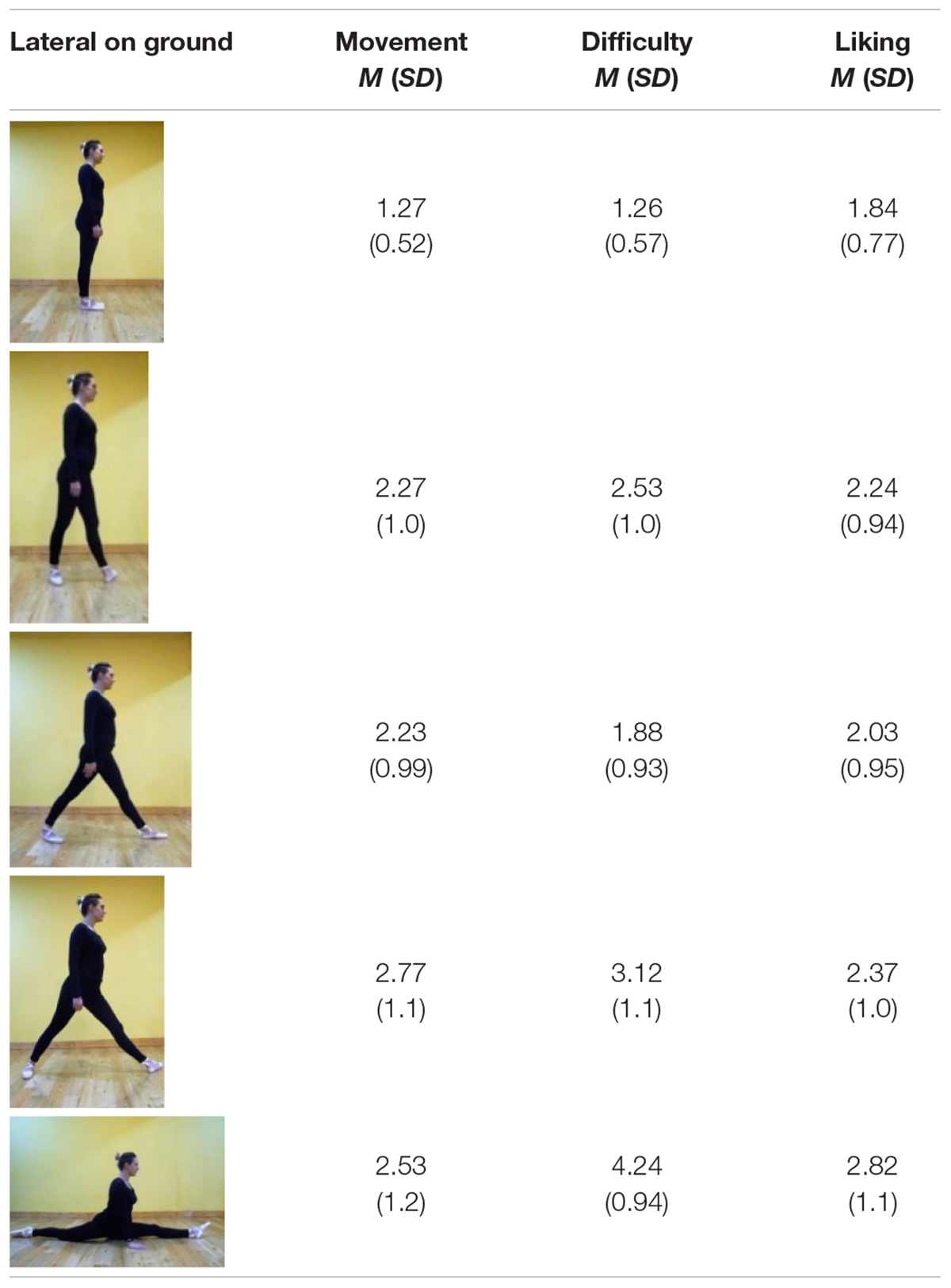- 1Department of Education, Roma Tre University, Rome, Italy
- 2Department of Psychology, University of Toronto, Toronto, ON, Canada
Usain Bolt’s Lightning Bolt pose, one arm highly extended to one side, suggests action. Likewise, static pictures of animals, legs extended, show animation. We tested a new cue for motion perception—extension—and in particular extension of dancer’s legs. An experiment with pictures of a dancer finds larger angles between the legs suggest greater movement, especially with in-air poses and in lateral views. Leg positions graded from simply standing to very difficult front and side splits. Liking ratings (a small range) were more related to Difficulty ratings (a large range) than Movement ratings (a moderate range).
Introduction
Though it is static, Usain Bolt’s Lightning Bolt pose, one arm highly extended to one side, suggests vigorous action. Likewise, in pictures of people and animals, leg spread may suggest animation.
Greatly admired poses in profile and frontal view suggest motion. For example, in a frontal view, Leonardo’s “Vetruvian Man” elevates his arms and separates his legs. Further, in a side view, Gericault’s Derby horses are in a flying gallop, legs stretched out fore and aft. Indeed, the further a horse spreads its legs, the speedier it seems, but observers deem the flying gallop unrealistic (Mastandrea and Kennedy, 2018). Comic books use motion lines and blur to suggest action (Gombrich, 1964; Kennedy, 1982; Carello et al., 1986; Cohn, 2013). The devices are often omitted if pose biomechanics are obvious (Juricevic, 2017). The pictorial devices activate motion-sensitive cortex (Kourtzi and Kanwisher, 2000; Cattaneo et al., 2015), and in a study on observers examining photographs of human actions, implied motion increased cortical activation (Proverbio et al., 2009). Cortical activation is particularly strong for pictured movements rated as pleasing and difficult to reproduce (Cross et al., 2011). Cortical activation levels might indicate amount of depicted motion perceivers report, and impressions of the perceived position of stationary objects (Pinna and Brelstaff, 2000; Pavan et al., 2011). A cortical AON or action observation network is thought to be triggered by static images and might be related to the observer’s own skills (Orlandi et al., 2020b).
Research into dance aesthetics has often examined subjective features such as familiarity, Orlandi et al. (2020a) note, pointing out that the studies rarely studied objective features. Research on observation of dance styles varies aggregations of features (Calvo-Merino et al., 2005). Similarly, research on observing motion and dance structure considers combinations of poses, good continuation and the grammar of dance (Orgs et al., 2013). Here we focus on one feature—extension of legs with increasing angles between the legs.
In art, wide limb spread has been used to convey extremes of movement. A celebrated Scots Greys Charging oil painting from 1881 by Lady Butler shows horses from in front in the center of the picture, and to the side of the image shows horses in lateral view. Most of the hooves in the picture are off the ground, front legs reaching forward, and rear legs backward. In contrast, a lateral picture of a rearing horse, back legs both on the ground, almost vertical, a very difficult pose to maintain, Jacques-Louis David’s Napoleon Crossing the Alps, from 1801, suggests motion upwards has occurred. Mastandrea and Kennedy (2018) sampled pictures of horses from the art world and found liking was correlated positively with motion. However, they included unrealistic limb poses and, since the stimuli were horses, they were not concerned with ratings of difficulty for human participants.
Here, we test photographs of a dancer varying in limb spread—the angle between extended legs. Will motion ratings increase with spread? In addition to the Cutting (2002) indicators of movement in pictures (broken symmetry, multiple images, forward lean, blur, action lines), leg extension, varying angles between legs, may suggest amount of motion. Of interest, Arnheim (1974) suggested liking would increase with the display’s dynamic qualities. Cross et al. (2011) suggest the skill level or difficulty of a pose may be more influential. Various relationships between movement, difficulty and liking have been reported. The typical viewer encodes effortful movements in a less refined way than professional dancers (Orlandi et al., 2020b). Does this mean ordinary observers do not find movement, difficulty and liking highly related? In observations of professional dancers undertaking complex dance movements, Cross et al. (2011) found a positive relation between difficulty and liking. Also, a positive relationship between amount of practice of small-muscle (eye muscle) motions and liking of observed images was reported by Topolinski (2010). At an extreme, difficulty might appear unpleasant. Much may depend on the poses considered and their range. Here we consider a dancer in a range of formal poses covering from simply standing to the full splits.
If a picture is from an unrevealing vantage point, being literally correct is no assurance of information for dynamics and biomechanics (Heller et al., 2002; Mastandrea and Umiltà, 2016). In this study we investigate if leg angles—limb spread—have implications for motion. As the angle between the legs increases, is more motion indicated? We test this hypothesis with photographs of a dancer in different realistic poses. We used pictures of a dancer in-air, capturing a frozen moment of vigorous action, and ones of a dancer on the ground, in which motion might be implied as in Lightning Bolt. Leg spread was symmetrical about vertical, and we provided views in which both legs and their spread was always obvious, not obscured. Under these conditions, Gibson (1979) and Di Dio et al. (2016) argued that sensory arrays provide rich information for dynamics. Leg angle matters for ground-based terrestrial animals such as horses and people—quadrupeds and bipeds—offering support at rest when vertical and on-ground, and suggesting motion and effort at other angles and in-air.
We asked participants to rate Figures 1, 2 for motion, expecting increases with spread. We also asked for likability and difficulty ratings. Since the photographs are of a professional dancer in formal poses, we expected all the pictures to be likeable. The range of likeability ratings might be modest as a result. Also, since the dancer was shown in poses from standing on the ground to the splits in the air and on-ground, and few ordinary observers can undertake the splits, the range of difficulty ratings might be wide. Of interest, the likability scores could be more related to motion ratings or more to difficulty ratings (Arnheim, 1974; Orgs et al., 2013; Orlandi et al., 2020b).
Our participants viewed pictures of a dancer in poses viewed from the front and the side, on-ground and jumping up (in-air), legs varying from parallel to widely separated in the splits, fully extended to the dancer’s left and right, or fore and aft. The postures include transient and sustained ones. Some have support from the ground, some have none. In-air poses are literally captured in-motion. Those on-ground at best imply motion. The issues we consider are: Do motion ratings increase reliably across the conditions, as limb angle increases? Or only in literal conditions i.e., in-air? How do lateral views compare to frontal views? Also, for likeability, is amount of movement outranked by difficulty?
Materials and Methods
Participants
Following standard practice at the university, potential subjects were contacted on-line, through the student social group of the Roma Tre University’s Department of Education. After agreeing to participate, students were invited to the Psychology Laboratory at the Department. A total of 100 participants volunteered (61 women, 39 men; mean age 35.2, SD 13.6). They reported no expertise in art and no professional dance experience. They had normal or corrected-to-normal vision and were naive about the purpose of the experiment. To participate in the study, they signed a written consent form.
Stimuli
The stimuli were 20 high-quality colored digital photographs of a dancer, in 4 sets of 5 (Figures 1, 2), shown via a monitor. Picture sizes in the display were between 12 and 18 cm in height and between 10 and 14 cm in width, with display resolution 36 dots per cm. They showed a female professional dancer, hair tied together at the back of the head, in white ballerina soft shoes and neck-to-ankle form-fitting black clothes—a dance outfit, leotard and top—set against a dark greenish-yellow textured ground and a plain lighter-colored wall. The dancer was pictured facing front and facing to the right (a lateral view). Arms were down except in splits (arms 40° to the body in this case) since in on-ground splits poses the arms reach the ground.
The leg-spread extents in the images range from 0 to 180°, measuring from heel to heel, vertex at the crotch. The intermediate angles are variable. For simplicity, we will refer to the angles in order by their means, rounded to the nearest 5° e.g., 20°, 40°, and 65°.
Photographs show a frozen moment and can specify an action (Gibson, 1979). Dancer poses in air are brief and on-ground can be sustained. A priori, this can affect ratings of motion, difficulty and likeability.
Figure 1 shows the dancer in a jump—in-air—and from in-front (top row) and from the side i.e., lateral. In the leftmost images, the legs are parallel, the torso is erect, and the arms, straight, are by the side, elbows-in (arms down in ballet, the first position in the Cecchetti and Bournonville methods but with elbows-in). On the right, in splits, the legs are aligned horizontally.
In the top left image in Figure 1, the dancer’s legs are parallel, 0° apart, and the torso is in an erect posture. In the neighboring image the legs are 20° apart. In the middle image in the row the legs are 35° apart, and in the next image 55°. On the right, the legs are extended to the dancer’s left and right and aligned with each other. A skilled, difficult dance motion, it is a side split. We will refer to it as 180°.
In the lower row, the camera vantage point is from the dancer’s right side. The dancer’s head and body face right. After the leftmost picture—erect—one leg is to the fore and one to the rear. In the rightmost image, the legs are aligned horizontally, with a wide spread, 180°, fore-and-aft of the dancer. This is a front split, and difficult. In other poses the dancer jumps with her torso erect, feet pointed downwards. In order, the images in the bottom row are 0° spread (legs together), 10°, 25°, 45°, and 180°.
Figure 2 offers similar poses to Figure 1 but on the ground. The angles between the legs range from 0° (vertical legs) to 180° (horizontal).
In the top row, photographed from in front, on-ground, the legs spread to the left and right sides of the dancer. Lesser spreads (in order, left to right, 0°, 20°—roughly, second position in ballet—45° and 80°) have feet flat on the ground. Two poses on the left (0° and 20°) are standing since the torso is vertically above the heels. This is biomechanically efficient. It is relatively static, though in practice, in maintaining upright stance, the body oscillates to and fro, mostly in the sagittal plane, like an inverted pendulum (Carello and Turvey, 2017). In 45° and 80°spreads, the body is not vertically above the heels. The legs form acute angles with the ground, and are straddling. The heels are not below the torso, and compared to standing are inefficient biomechanically. In the extreme posture, the 180° side split, the ground supports the legs, but the pose is highly difficult.
The lower row of on-ground images in Figure 2 are taken from a vantage point on the right side of the dancer. The leftmost pose is standing, 0° leg separation. In the next three images from the left, the left foot is forward, as if the dancer was stepping. In the shortest step, leg separation 30°, the rear thigh is vertically aligned with the body, supporting the body against gravity, but both of the feet are wide of the torso, not under it. In the two longer strides (65° and 80° leg separations), neither heel is under the torso. The 35°, 65°, and 80° leg-separation poses are biomechanically inefficient. The bottom-right image offers an especially difficult pose, a front split, legs close to alignment horizontally, 180° apart, the right knee on the ground, and the thigh raised. The contact with the ground in this pose can be difficult to sustain.
In Figure 1, top row, the frontal-view, the arms, are downwards in the sagittal plane of the body, and accommodate the leg spread, but in the splits the arms are about 40° to the body. To be comparable, in the splits in side-view each arm is again about 40° to vertical. In Discussion, we note that subtle variations in biomechanical efficiency, and arm and foot poses, are associated with limb spread in realistic photographs of dancers.
Procedure
Participants were seated in an isolated laboratory room, in front of a 48 cm computer monitor located at a distance of about 60 cm from the participant’s head. The pictures were presented one at a time on the computer monitor. To randomize the presentation, we used four different power-point slide shows, with different orders of the pictures. Participants answered three questions, in Italian, here translated as (1) “How much movement is shown in the picture?” (2) “How much do you like this picture?” (3) “How difficult is it to assume this position?” The answers were given on a Likert scale, from 1 (not at all) to 5 (very much). Every participant was given a booklet; each page contained the three written questions. After the exposure to each image, participants were required to respond to the questions by checking a number on the scale, with no time limit. Once the assessment of one stimulus was completed he/she had to press the enter button to move to the next image and turn the booklet to the next page to answer the same three questions; this task was performed for all the 20 stimuli. The duration of the experiment was about 10 min.
Results
Each participant responded to all the items and questions, giving 20 scores per scale. Offering details of the findings, mean scores (and SD) for each pose are in Tables 1–4.
To summarize the findings, mean scores of the three dependent variables (Movement, Difficulty and Liking per view), On-ground and In-air, are in Figure 3.
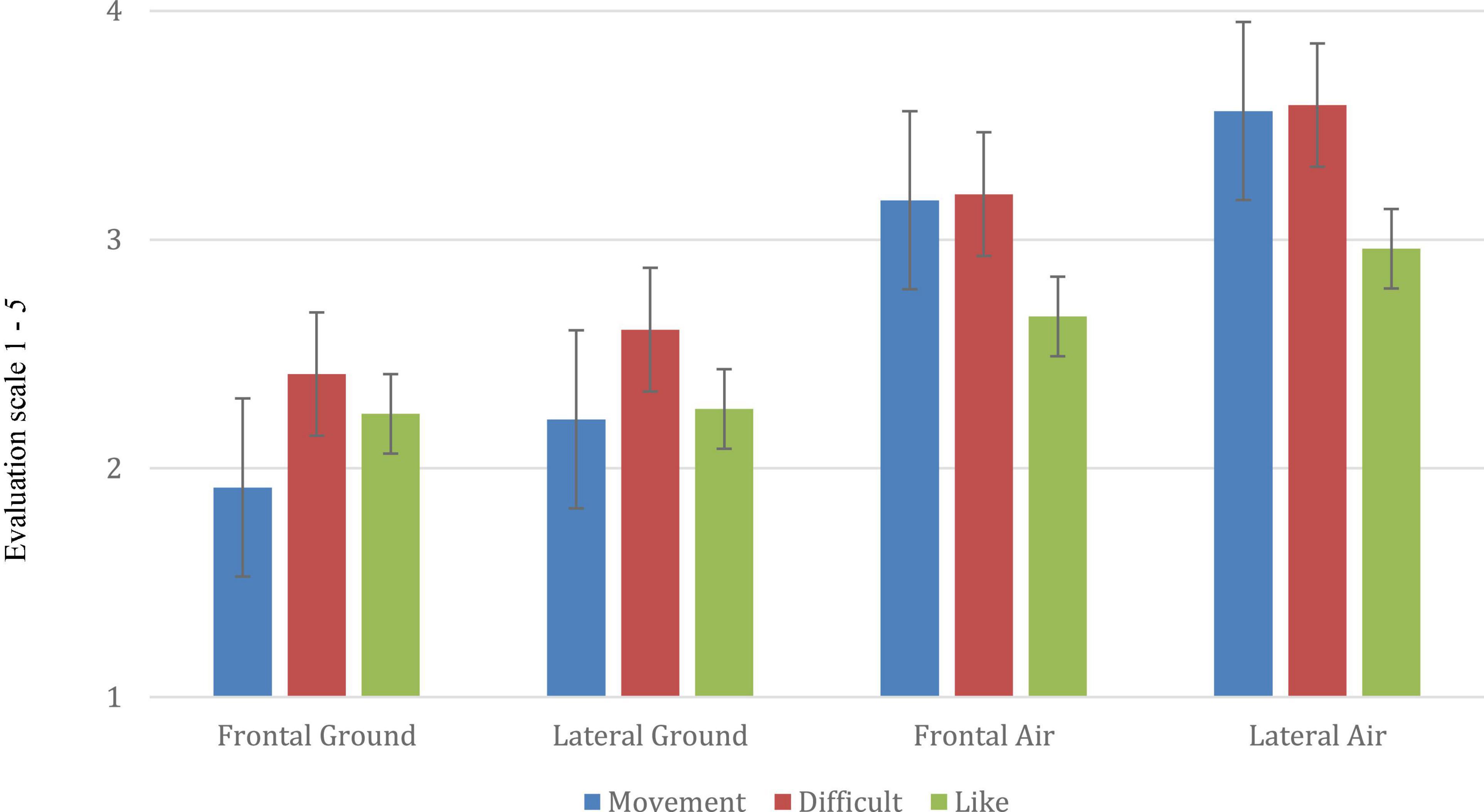
Figure 3. Mean scores for the three variables, Movement, Difficulty and Liking for the four poses, Frontal On-ground, Lateral On-ground, Frontal In-air and Lateral in-air.
We will offer descriptive statistics and then proceed to reliability analyses. For ease of comprehension, we comment briefly on some findings. Movement and Difficulty were influenced greatly by leg angle, and Liking less, and In-air scores were higher than On-ground, with Lateral In-air scores especially high. We will note a restriction of range for Liking, and that symmetry may matter.
Overall, ranges were considerable and, as Figure 3 suggests, floor and ceiling effects were avoided. For Movement, the range of mean scores per pose was 2.75, from 1.18 (Frontal, on ground, 0°) to 3.93 (Lateral, in-air, 180°). For Difficulty the range of scores was 3.59, from 1.15 (Frontal, on ground, 0°) to 4.74 (Lateral, in-air, 180°). For Liking, the range was only 1.68, from 1.84 (Lateral on ground, 0°), to 3.52 (Lateral, in-air, 180°). For individual poses, the Difficulty range was greater than that for Movement and double that for Liking.
Comparisons of means of the dependent variables (Movement, Like and Difficulty) for each of the 4 pose conditions are shown in Figures 4–6. Across the dependent variables, In-air conditions had especially high scores.
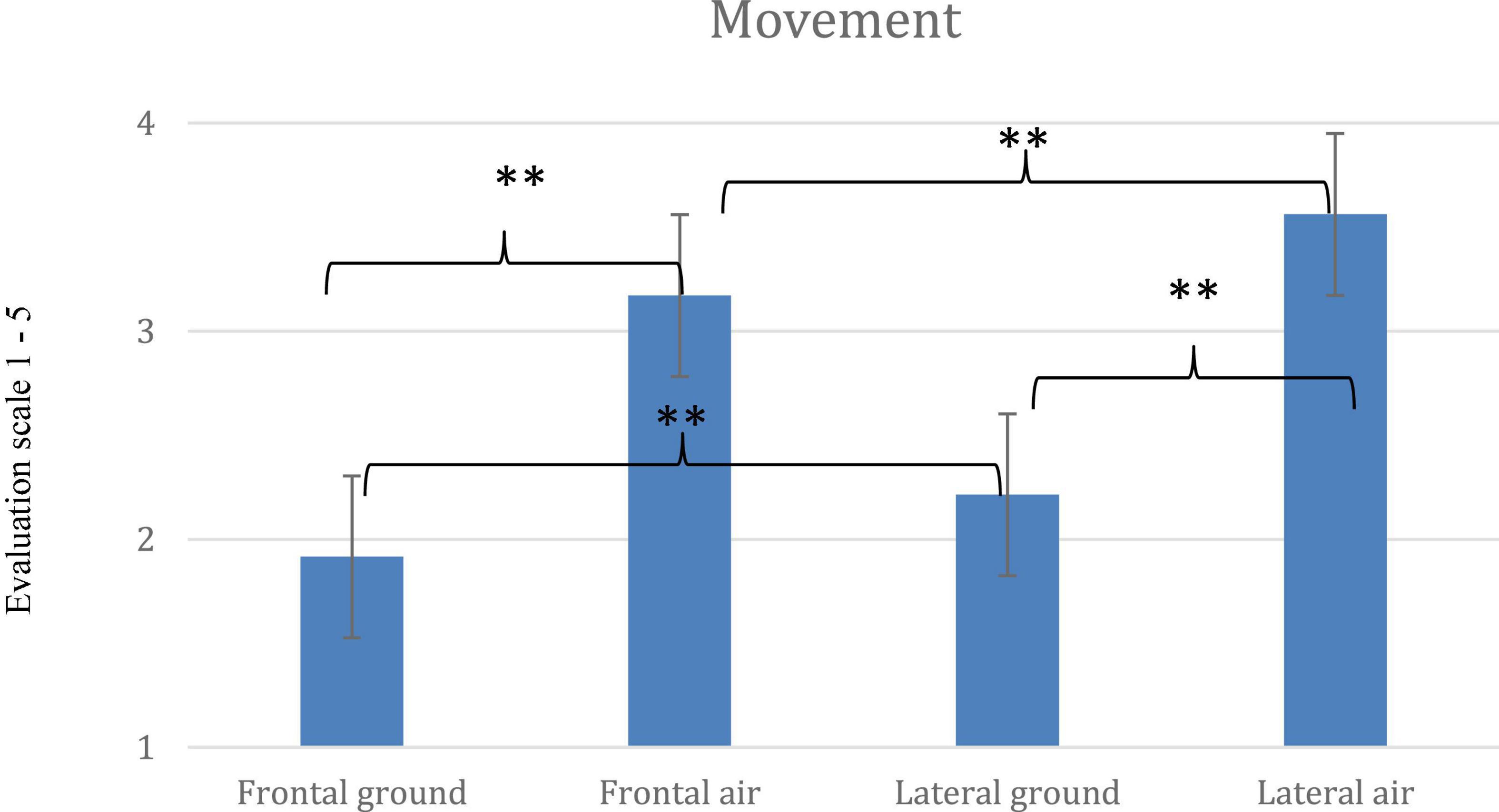
Figure 4. Mean scores for Movement and significant interaction for the four poses, Frontal On-ground, Lateral On-ground, Frontal In-air and Lateral In-air (error bars indicate standard errors of the means; ** = < 0.001).
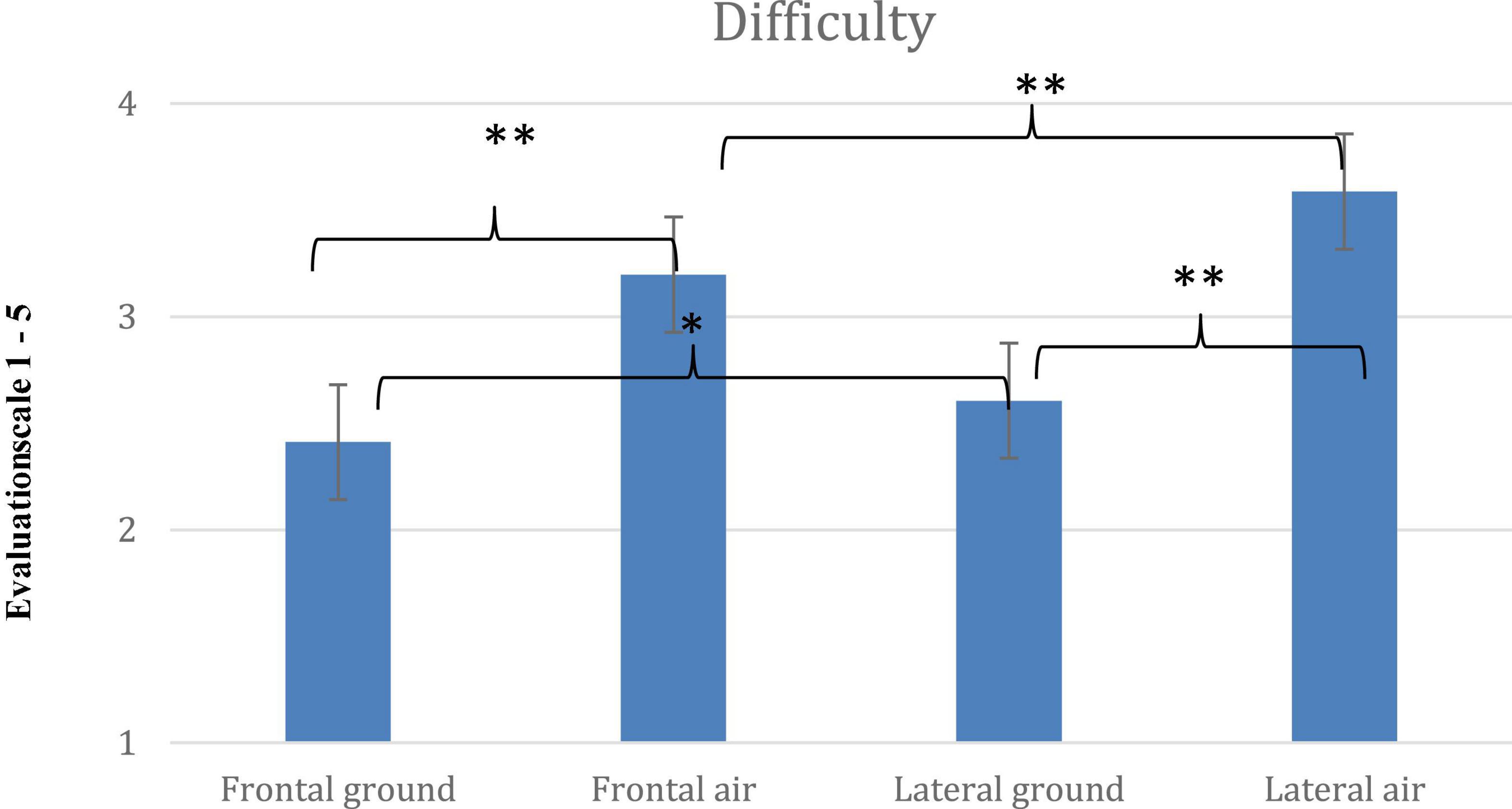
Figure 5. Mean scores for Difficulty and significant interaction for the four poses, Frontal On-ground, Lateral On-ground, Frontal In-air and Lateral In-air (error bars indicate standard errors of the means; * = < 0.05; ** = < 0.001).
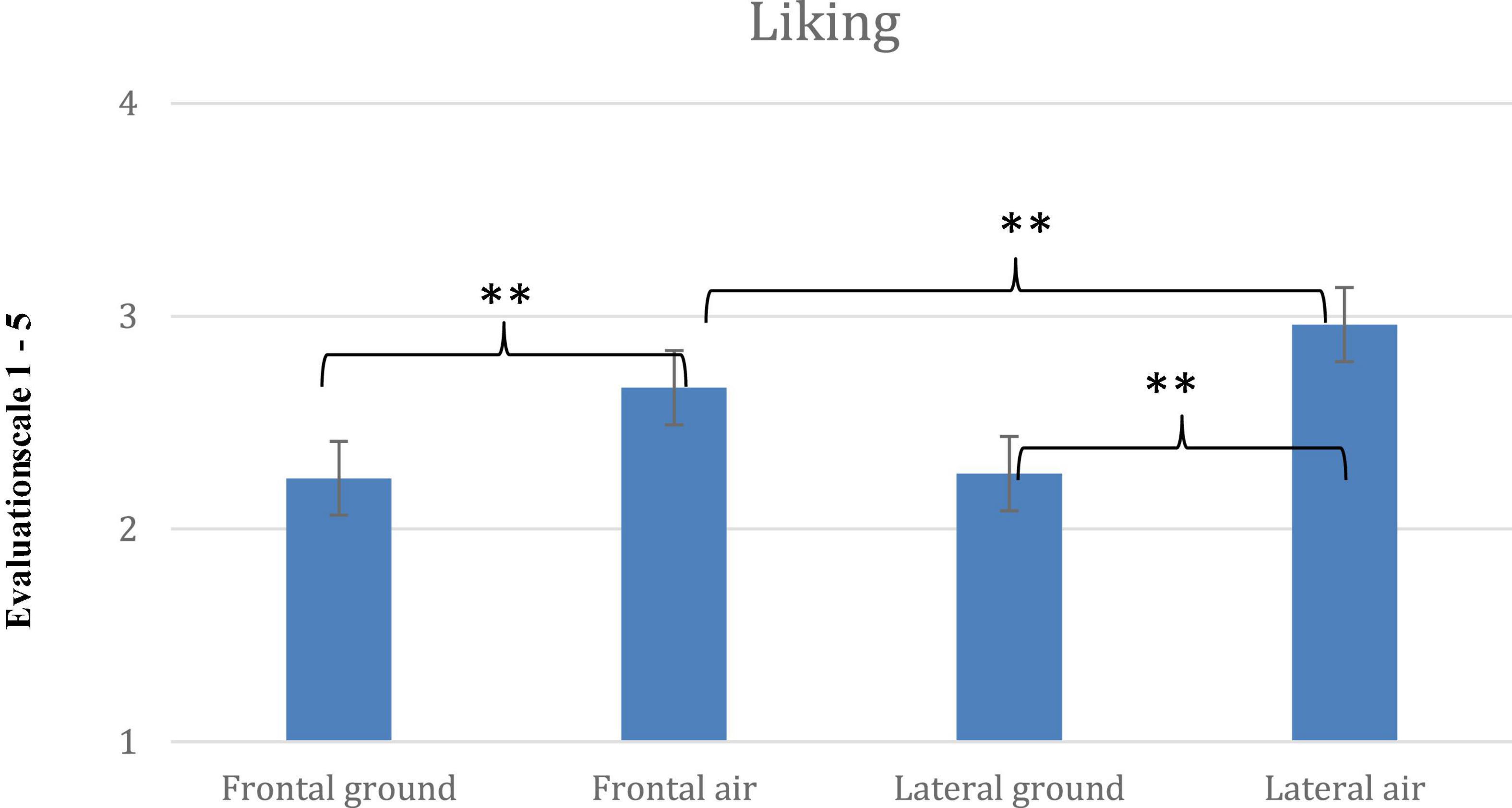
Figure 6. Mean scores for Liking and significant interaction for the four poses, Frontal On- ground, Lateral On-ground, Frontal In-air and Lateral In-air (error bars indicate standard errors of the means; ** = < 0.001).
Repeated-measure ANOVAs were conducted for each of the dependent variables, Movement, Difficulty and Liking, with a 5 × 2 × 2 factorial design: Leg angles (5 levels: 5 degrees of spread) × Vantage-point (2 levels: frontal and lateral) × Elevation (2 levels: on-ground, in-air).
Movement
For Movement, the main effect of leg angles was significant [F(4, 396) = 84.884; p < 0.001, η2 = 0.462]. Greater angles meant more movement. The main effect of the camera Vantage-point was significant [F(1, 99) = 74.400; p < 0.001, η2 = 0.429]. Lateral-view movement ratings were higher than frontal. Similarly, the main effect of air or ground Elevation was significant [F(1, 99) = 151.222; p < 0.001, η2 = 0.604]. In-air ratings were much higher than On-ground.
For Movement, a three-way interaction (Leg angles × Vantage-point× Elevation) was significant [F(4, 396) = 5.798; p < 0.001, η2 = 0.055]. Post-hoc t-tests were run. Ratings for In-air and Lateral poses were notably high—reaching M = 3.93 for the splits.
Comparisons using the two most extreme poses—the splits and 0°—are clear. Lateral In-air 0° (M = 3.35) offered more movement than Frontal In-air 0° (M = 2.93) p < 0.001; d = 0.29, which offered more than Lateral On-ground 0° (M = 1.27; p < 0.001; d = 1.94); Lateral On-ground was not different from Frontal On-ground 0° (1.18), NS.
Regarding the 4 splits poses with legs 180° apart: Lateral In-air (M = 3.93) was rated higher than Frontal In-air (M = 3.33, p < 0.001; d = 0.58), which was higher than Lateral On-ground (M = 2.53), p < 0.001; d = 1.07), which was similar to Frontal On-ground (M = 2.34) = NS.
Lateral In-air poses are literally part of upward motion and may also benefit from implying extra movement, to the side. Movement scores increase steadily with leg angle in the Lateral positions in-air—a leap forward as well as upward—and less steadily in other conditions.
Difficulty
The main effect of leg-angle in the ANOVA for Difficulty (Leg angles x Vantage-point x Elevation) was significant [F(4, 396) = 411.613; p < 0.001, η2 = 0.806], with larger angles rated more difficult. The main effect of Vantage-point was significant [F(4, 396) = 58.321; p < 0.001, η2 = 0.371], with poses shown in the Lateral viewpoint rated more difficult. The main effect of Elevation was also significant [F(1, 99) = 111.904; p < 0.001, η2 = 0.531]. In-air difficulty ratings were higher than On-ground.
The three-way interaction (Leg angles × Vantage-point× Elevation) was also significant [F(4, 396) = 11.008; p < 0.001, η2 = 0.100]. Post-hoc t-tests were run. Again, comparisons within the two most extreme poses –0° and the splits—are informative.
For 0°: Lateral In-air (M = 3.27) was rated more difficult than Frontal In-air (M = 2.8), p < 0.001; d = 0.4) and both were more difficult than Lateral On-ground (M = 1.26) and Frontal On-ground (M = 1.15), which were alike (and with ground support, standing Difficulty should indeed be minimal, and camera vantage point should be immaterial).
Regarding the splits: Frontal In-air (4.74), Frontal On-ground (4.42) and Lateral On-ground (4.24) were alike, and each was more difficult than Lateral In-air (3.27) (all p < 0.001). The splits is difficult, but Lateral In-air (3.27) may seem like a leap upwards and forward, and thereby close to part of an observer’s skill set.
Difficulty of Frontal On-ground poses, including straddling poses that are hard to maintain, increased more steadily with leg angle (in order, from 1.15 to 1.75, 1.99, 2.75, and 4.42) than poses in other conditions, but the pose rated most difficult was the lateral in-air splits (4.74) that has no ground support.
Liking
In general, the larger the angle the more the pose was liked, but no condition offered consistent increases in Liking, which can be expected given the small range of Liking scores, and high scores given to 0° in-air poses. The ANOVA for Liking included Leg angle x Vantage-point x Elevation. The main effect of leg angle was significant [F(4, 396) = 102.956; p < 0.001, η2 = 0.510]. The larger the angle the higher the rating. The main effect of Vantage-point was significant [F(1, 99) = 18.293; p < 0.001, η2 = 0.156]. Lateral poses were liked slightly more than Frontal ones The main effect of Elevation was also significant [F(1, 99) = 53.265; p < 0.001, η2 = 0.350], with in-air poses rated higher.
The three-way interaction (Leg angle × Vantage-point × Elevation) was also significant [F(4, 396) = 5.738; p < 0.001, η2 = 0.055]. Post-hoc t-tests were run. Once again, comparisons within the two most extreme poses—0° and the splits—are informative.
For 0° poses, the Lateral In-air pose (M = 2.76) was liked more than any other (p < 0.001), and the Frontal In-air pose was preferred to the On-ground poses which were alike.
Regarding the splits: the Lateral In-air pose (M = 3.52) was liked above the others, including Frontal In-air (M = 3.29; p < 0.05; d = 0.17), and p < 0.001 for the other comparisons. Frontal In-air was preferred to the on-ground poses (p < 0.05), and Frontal On-ground (M = 3.06) was liked more than Lateral on-ground (M = 2.82) (p < 0.05; d = 0.11). Along with notable difficulty, Lateral in-air has upward and sideways movement options. The Lateral On-ground pose is less symmetrical than the frontal poses.
Liking scores increased slightly more steadily with leg angle for Frontal on-ground poses than for other poses, with the Liking scores decreasing with leg-angle only once, and slightly, from 1.91 for standing to 1.80 for legs-slightly apart (their symmetry may matter). For Lateral in-air poses, Liking scores begin with high ratings for 0° (restricting range) and eventually rose slightly with leg-angle—in order, 2.76, 2.76, 2.73, and then up to 3.03 and finally 3.52. Lateral on-ground Liking ratings (a small range) decreased once with leg-angle, and Frontal in-air Liking ratings (with high ratings for 0° poses restricting the range) decreased twice with leg angle.
Results of Pearson correlation indicated that Movement correlated positively with both Difficulty (r = 0.747; p < 0.001) and Liking (r = 0.808; p < 0.001). However, Difficulty correlated positively and very impressively with Liking (r = 0.949; p < 0.001), close to ceiling. To consider the relationship between the three variables, Liking, Movement and Difficulty, a multiple regression analysis was conducted. The regression model with the two predictors, Difficulty and Movement, explained 92% of the variance [R2 = 0.92; F(2, 17) = 102.3, p < 0.001]. Difficulty significantly predicted Liking (β diff. = 0.37, p < 0.001); Movement also predicted liking but with a weaker effect (β mov = 0.14, p < 0.05), indicating Difficulty has an extra effect over and above Movement.
Discussion
For observations of images of motion, the relations between indications of movement, apparent difficulty and personal liking have been debated (Arnheim, 1974; Topolinski, 2010; Cross et al., 2011; Orlandi et al., 2020a,b). Here we consider these factors in reports of impressions of a dancer in formal poses showing a range of leg angles.
In the present case, as hypothesized, Movement ratings increase with limb angle, especially in-air in lateral views. In all 4 conditions—Frontal and Lateral In-air, and On-ground—the most-spread pose had higher Movement ratings than the least-spread. On-ground poses imply motion indirectly (like the Lightning-Bolt posture), and in-air images literally freeze mid-flight motion. Studies using verbal reports and cortical responses show that static images can convey implicit motion (Kourtzi and Kanwisher, 2000; Urgesi et al., 2006; Proverbio et al., 2009; Orgs et al., 2013). Here, leg extension in static pictures of a dancer conveyed motion. Likewise, for pictures of horses in gaits such as walk and trot, the more the legs were extended fore-and-aft the more motion observers reported (Mastandrea and Kennedy, 2018).
There may have been some influences from symmetry on Liking, but the clearest effect to consider is that Liking correlated less with Movement than with Difficulty. In this vein it is worth noting that Topolinski (2010) reported that liking increased with training in actual muscle movements, and muscle training is related to skill. Topolinski (2010) was concerned with visual muscles, however, and the present study concerns observation of large-muscle activity.
As expected, Movement ratings were highest for In-air conditions. Their ratings increased steadily with spread in the lateral views, which likely suggest a jump forward as well as a jump up, attracting the highest movement scores and the greatest movement range. In contrast, Frontal In-air views had very little range, though it should be said that, in some support of the movement-angle hypothesis, the lowest score was for 0° and the maximum scores were for 65° and 180° spreads. More emphatically and convincingly, at every angle, 0°–180°, the lateral views are rated higher than the frontal views for motion. The frontal view may merely suggest a jump upwards, and lateral views suggest upwards and in the direction to the side she faces.
On-ground Movement scores, which at best imply movement, were low and ranged from close to baseline, for standing erect, to midrange for the splits. Increases in on-ground ratings may be due to implied motions, such as deviating from standing, a default pose. The enhancement could also be due to increased effort required to maintain a straddling pose as limbs spread, since for both frontal and lateral on-ground views, the maximum Movement scores on the ground were biomechanically inefficient poses, legs spread 65°, and short of the highly difficult splits. At every angle, Lateral On-ground views are rated higher than frontal images, supporting the interpretation that frontal views suggest holding the pose and lateral views may indicate the end of the act of stepping forward.
As noted in regression analysis, Movement scores correlated positively with Difficulty and Liking, but the highest correlation, essentially at ceiling, was between Difficulty and Liking (r = 0.949). The explanation may be that dance entails extensively practiced skilled movements. It takes some skill to adopt and hold on-ground poses, and even the standing dancer in the present study is in a formal pose, head high, shoulders back, elbows by the side, torso erect. It may be skill in adopting a trained pose attracts Liking scores. Since all the poses are formal, Liking ratings have a restricted range. But some of the poses are especially difficult to master, particularly leaps with full-extension leg spread extending fore-and-aft of the dancer or to the dancer’s left and right. Difficulty may be a proxy for skill, particularly a skill level beyond the observer’s. If so, rather than motion being liked, or difficulty being liked, it is skill that is liked. In a study on timing of actions, dance movement sequences judged more effortful, and more difficult (reproducible by the observer), were more aesthetically pleasing (Orlandi et al., 2020a). Besides Difficulty, in the present study with static pictures of a dancer, increase in Movement is related to Liking.
We should note that the dancer’s leg positions are accompanied by relatively fixed arms. This is a standard feature of some well-known dances. In Celtic dances, the arms are downwards in Irish step dance, and upwards, above the shoulders, curled, in Scottish highland dance, as in classical ballet’s 5th position of the arms, en haut in the Cecchetti method. In future research, combinations of arm and leg angles could test the limb-angle/movement hypothesis. Thereby, the Liking range might increase, as the downward arm postures here offer a subdued range of expressions (Ross and Flack, 2019).
In photographs of an actual dancer, as here, as a matter of practicality, some features of the feet, arms, torso and head are not as controlled as they would be in drawings. For example, in Figure 1’s lateral images, the dancer’s head is erect in the 0° pose, but it comes forward steadily in the 20–180° images. In a future study this would deserve attention.
The results here may be important and relevant for the psychology of art and motion depiction. A photograph of a dancer, legs extended, far apart, can convey a vivid sense of motion, offer a difficult pose and yet be highly liked. Designers and artists may find it useful to know that large angles between limbs boost implied motion, and just as helpful to know that postures difficult to achieve may be highly admired. Perception psychologists may find that high levels of implied motion in pictures of real-life dancers have many cortical and perceptual effects e.g., motion after-effects (Winawer et al., 2008).
Conclusion
In conclusion, in ratings of photographs of a dancer in-air (especially) and on-ground (slightly), in frontal and lateral view, increase in leg angle suggested more motion. Evidently, limb extension is a factor suggesting motion in static pictures. Also, in-air poses are in the midst of an actual leap, and on-ground poses may suggest motion in indirect fashion. Lateral views may benefit from suggesting movement sideways. Difficulty and Liking scores increased from erect poses to the splits. However, Liking (small range) was more related to Difficulty (large range), and possibly skill, than Movement (intermediate range).
Data Availability Statement
The raw data supporting the conclusions of this article will be made available by the authors, without undue reservation.
Ethics Statement
Ethical review and approval was not required for the study on human participants in accordance with the local legislation and institutional requirements. The patients/participants provided their written informed consent to participate in this study. Written informed consent was obtained from the individual(s) for the publication of any potentially identifiable images or data included in this article.
Author Contributions
SM conceived the idea of this study, and performed the testing, data collection, and statistical analysis. SM and JK interpreted the results, wrote, and approved the final version of the manuscript. Both authors contributed to the article and approved the submitted version.
Funding
This research project was funded by the Department of Education of the Roma Tre University in the year 2020–2021.
Conflict of Interest
The authors declare that the research was conducted in the absence of any commercial or financial relationships that could be construed as a potential conflict of interest.
Publisher’s Note
All claims expressed in this article are solely those of the authors and do not necessarily represent those of their affiliated organizations, or those of the publisher, the editors and the reviewers. Any product that may be evaluated in this article, or claim that may be made by its manufacturer, is not guaranteed or endorsed by the publisher.
Acknowledgments
We thank Giulia Chianchini for research assistance. For helpful comments, our reviewers deserve many thanks.
References
Calvo-Merino, B., Glaser, D. E., Grèzes, J., Passingham, R. E., and Haggard, P. (2005). Action observation and acquired motor skills: an FMRI study with expert dancers. Cereb. Cortex 15, 1243–1249. doi: 10.1093/cercor/bhi007
Carello, C., and Turvey, M. (2017). Useful dimensions of haptic perception: 50 years after the senses considered as perceptual systems. Ecol. Psychol. 29, 95–121.
Carello, C., Rosenblum, L., and Grosofsky, A. (1986). Static depiction of movement. Perception 15, 41–58.
Cattaneo, Z., Schiavi, S., Silvanto, J., and Nadal, M. (2015). A TMS study on the contribution of visual area V5 to the perception of implied motion in art and its appreciation. Cogn. Neurosci. 8, 59–68. doi: 10.1080/17588928.2015.1083968
Cross, E. S., Kirsch, L., Ticini, L. F., and Schütz-Bosbach, S. (2011). The impact of aesthetic evaluation and physical ability on dance perception. Front. Hum. Neurosci. 5:102. doi: 10.3389/fnhum.2011.00102
Cutting, J. E. (2002). Representing motion in a static image: constraints and parallel in art, science and popular culture. Perception 10, 1165–1193. doi: 10.1068/p3318
Di Dio, C., Ardizzi, M., Massaro, D., Di Cesare, G., Gilli, G., Marchetti, A., et al. (2016). Human, nature, dynamism: the effects of content and movement perception on brain activations during the aesthetic judgment of representational paintings. Front. Human Neurosci. 12:705. doi: 10.3389/fnhum.2015.00705
Heller, M. A., Brackett, D. D., Scroggs, E., Steffen, H., Heatherly, K., and Salik, S. (2002). Tangible pictures: viewpoint effects and linear perspective in visually-impaired people. Perception 31, 747–769. doi: 10.1068/p3253
Juricevic, I. (2017). Analysis of pictorial metaphors in comic book art: test of the LA-MOAD theory. J. Graph. Novels Comics 9, 1–21.
Kourtzi, Z., and Kanwisher, N. (2000). Activation in human MT/MST by static images with implied motion. J. Cogn. Neurosci. 12, 48–55. doi: 10.1162/08989290051137594
Mastandrea, S., and Kennedy, J. M. (2018). Gericault’s fake-gallop horse judged speedy but unrealistic. Art Percept. 6, 77–96. doi: 10.1163/22134913-20181094
Mastandrea, S., and Umiltà, M. A. (2016). Futurist art: motion and aesthetics as a function of title. Front. Hum. Neurosci. 10:201. doi: 10.3389/fnhum.2016.00201
Orgs, G., Hagura, N., and Haggard, P. (2013). Learning to like it: aesthetic perception of bodies, movements and choreographic structure. Conscious. Cogn. 22, 603–612. doi: 10.1016/j.concog.2013.03.010
Orlandi, A., D’Incà, S., and Proverbio, A. M. (2020b). Muscular effort coding in action representation in ballet dancers and controls: electrophysiological evidence. Brain Res. 1733:146712. doi: 10.1016/j.brainres.2020.146712
Orlandi, A., Cross, E. S., and Orgs, G. (2020a). Timing is everything: dance aesthetics depend on the complexity of movement kinematics. Cognition 205:104446. doi: 10.1016/j.cognition.2020.104446
Pavan, A., Cuturi, L. F., Maniglia, M., Casco, C., and Campana, G. (2011). Implied motion from static photographs influences the perceived position of stationary objects. Vis. Res. 51, 187–194. doi: 10.1016/j.visres.2010.11.004
Pinna, B., and Brelstaff, G. J. (2000). A new visual illusion of relative motion. Vis. Res. 40, 2091–2096. doi: 10.1016/s0042-6989(00)00072-9
Proverbio, A. M., Riva, F., and Zani, A. (2009). Observation of static pictures of dynamic actions enhances the activity of movement-related brain areas. PLoS One 4:e5389. doi: 10.1371/journal.pone.0005389
Ross, P., and Flack, T. (2019). Removing hand form information specifically impairs emotion recognition for fearful and angry body stimuli. Perception 49, 98–112. doi: 10.1177/0301006619893229
Topolinski, S. (2010). Moving the eye of the beholder: motor components in vision determine aesthetic preference. Psychol. Sci. 21, 1220–1224. doi: 10.1177/0956797610378308
Urgesi, C., Moro, V., Candidi, M., and Aglioti, S. M. (2006). Mapping implied body actions in the human motor system. J. Neurosci. 26, 7942–7949. doi: 10.1523/jneurosci.1289-06.2006
Keywords: motion, dancer, leg, extension, difficulty, liking, static pictures
Citation: Mastandrea S and Kennedy JM (2022) Extension of Dancer’s Legs: Increasing Angles Show Motion. Front. Psychol. 12:706004. doi: 10.3389/fpsyg.2021.706004
Received: 06 May 2021; Accepted: 08 November 2021;
Published: 04 January 2022.
Edited by:
Takahiro Kawabe, NTT Communication Science Laboratories, JapanReviewed by:
Andrea Orlandi, Sapienza University of Rome, ItalyLuca Battaglini, University of Padua, Italy
Copyright © 2022 Mastandrea and Kennedy. This is an open-access article distributed under the terms of the Creative Commons Attribution License (CC BY). The use, distribution or reproduction in other forums is permitted, provided the original author(s) and the copyright owner(s) are credited and that the original publication in this journal is cited, in accordance with accepted academic practice. No use, distribution or reproduction is permitted which does not comply with these terms.
*Correspondence: Stefano Mastandrea, c3RlZmFuby5tYXN0YW5kcmVhQHVuaXJvbWEzLml0
 Stefano Mastandrea
Stefano Mastandrea John M. Kennedy
John M. Kennedy